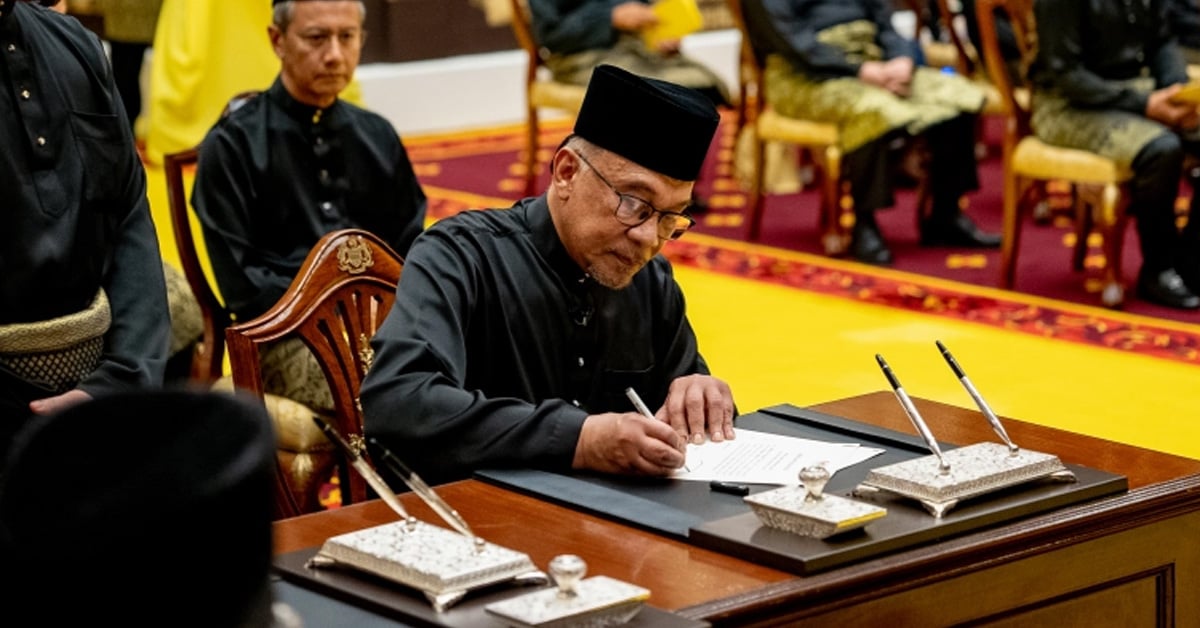On Thursday (24 November 2022), Pakatan Harapan (PH) chairman Anwar Ibrahim was sworn in as Malaysia’s 10th prime minister, ending his 24-year-long wait for this position.
Finally.
After the exhilarating series of events in this general election, we have finally come to an end.
Anwar’s Swearing-In Ceremony
75-year-old Anwar was dressed in a black baju melayu with a gold sampin and wore an excited smile as he was called upon to take his oath of office and secrecy.
This comes after the meeting that the Malaysian king, Sultan Abdullah Ahmad Shah, had with the nation’s nine state monarchs in the morning.
“After going through the views of the Malay rulers, His Majesty has consented to appointing Datuk Seri Anwar Ibrahim as Malaysia’s 10th prime minister,” said Royal Comptroller Fadli Shamsuddin on Thursday afternoon.
At the ceremony, there were many top officials in attendance, such as the chief secretary to the government, the Chief Justice, the Attorney-General, Speakers of both Houses of Parliament, and leaders from both PH and Barisan Nasional (BN).
Mr. Anwar was seated next to his wife and their six children.
“This trust will be borne with humility and responsibility. I will carry out this solemn duty with my team guided by the will and desire of the people,” Mr. Anwar announced in a tweet after the ceremony.
After the announcement of him becoming Prime Minister, the ringgit currency surged upon the end of this political deadlock.
Anwar had suffered a lot but did not give up. He was once sacked as Deputy Prime Minister, then sentenced to jail three times for charges like sodomy and corruption with a total of 11 years on his record.
Nonetheless, he has pushed on and finally reached this position after 24 years.
Hard-fought battle finally won.
Muhyiddin Disputes Decision
With his loss, former prime minister Muhyiddin Yassin insisted that he commanded the majority support of lawmakers in the federal Parliament to lead the government.
He then called on Anwar to prove that the latter has the support of the majority of MPs to lead the country.
For context, because of the hung parliament, both PH and Perikatan Nasional (PN) had to form alliances to attain a simple majority to form a government. In the parliament of 222 seats, they had to get 112 seats to emerge victorious.
Mr. Muhyiddin told a news conference that he had 115 statutory declarations (SDs) of Members of Parliament backing him as the prime minister when he submitted their names on Tuesday to the national palace.
“For the sake of the confidence of the people, Anwar should prove that he has the support of the majority of members of the Dewan Rakyat (Parliament),” Mr. Muhyiddin said.
Additionally, he explained the composition of the lawmakers supporting him: 73 MPs from his PN, 23 MPs from Gabungan Parti Sarawak (GPS), six MPs from Gabungan Rakyat Sabah, one mp from Sabah’s Parti Kesejahteraan Demokratik Masyarakat (KDM), 10 MPs from BN, and two independent MPs.
“All these documents were sent to Istana Negara at 1.28 pm on November 21, which is before the deadline set for parties to send related documents to Istana Negara, as required by the Speaker of the House of Representatives,” Mr. Muhyiddin said at the news conference.
As such, he believed that he had won.
However, the BN MPs were said to have retracted their SDs as a sign of the party’s impartiality. GPS did the same and said that it would support the lead governing party picked by the Sultan.
Hung Parliament
Malaysia saw its first-ever hung parliament this election.
Anwar Ibrahim and Muhyiddin Yassin, with 82 and 79 seats respectively, had to achieve a simple majority of 112 seats in the 222-seat legislature to form a government.
After the casting of the votes, while there was a winning party with the most seats, there was no government formed.
Wait, what? How?
First, let’s understand how the system works.
As we all know, the number of votes is proportional to the number of seats won: more votes equals more seats in parliament. Simple, right?
Next, we have to comprehend how a government is formed.
The government is not formed by the party with the most seats. It is formed by the party with the majority of the seat. In other words, a party has to have not only the most number of seats, but also more than half of the seats, in order to form the government.
In Malaysia’s case, the dominating party, PH coalition, secured 82 seats in the 222-member parliament. It secured the most seats, but not the majority. Simply put, it checks only one of the two boxes required.
So, what now?
In this case, since there is no government formed, we refer to the scenario as having a “hung parliament”.
When this happens, parties can band together and form alliances. Through this, they form larger bodies and their seats are combined. This would allow parties to check the second box in forming a government.
No alliances were formed and the king had to step in.
Now, after a long wait for the king’s decision, the country has finally found its prime minister: Mr. Anwar Ibrahim.
Featured Image: Al Jazeera



